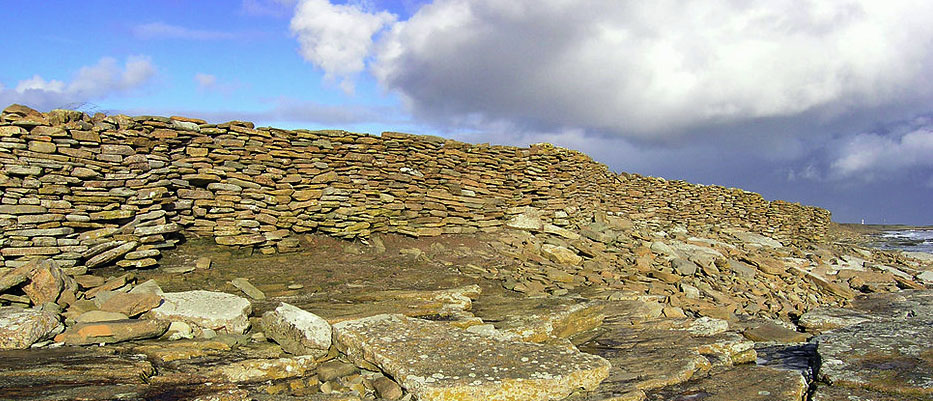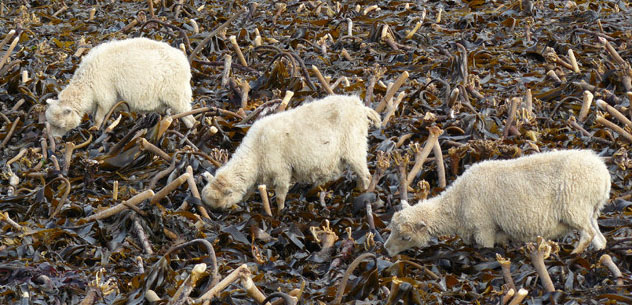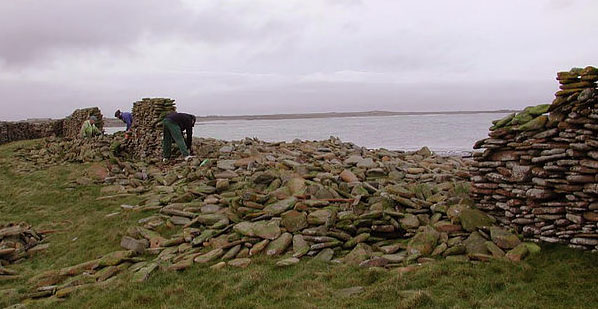Sheepdyke Restoration Project

History of the Sheepdyke
North Ronaldsay boasts an unusual 13 mile drystone sheepdyke that runs around the perimeter of the Island. It is Grade A listed and recognised as the longest freestanding drystone structure in Europe, if not the World.
Following the collapse of Orkney’s kelp industry in the early 1830s, the then Laird, John Traill, ![]() determined that the most lucrative use of the Island’s land and resources would be agriculture and cattle farming. In order to utilise the available acreage to its full potential, the Island’s native sheep had to be pushed off the land and onto the foreshore – thus a sheepdyke barrier was built above the high-tide mark and the ancient breed suddenly confined to just 271 acres of sand and rock.
determined that the most lucrative use of the Island’s land and resources would be agriculture and cattle farming. In order to utilise the available acreage to its full potential, the Island’s native sheep had to be pushed off the land and onto the foreshore – thus a sheepdyke barrier was built above the high-tide mark and the ancient breed suddenly confined to just 271 acres of sand and rock.

Three Shorn North Ronaldsay Sheep Eating Kelp
Rather than perish, the small and hardy flock thrived in their new habitat, quickly adapting to an almost exclusive diet of seaweed washed onshore from the North Atlantic. This mineral-rich and bountiful resource now feeds some 3,000 sheep on the Island, which are only brought inland for the short lambing season. Uniquely, the North Ronaldsay flock are actually at their prime weight in Winter, when stormy seas throw even more generous quantities of kelp onto the foreshore – a recipe for survival in an otherwise unforgiving environment. The sheepdyke’s maintenance fell to the Island crofters, who formed an agreement with the Laird – they would be allowed to keep a fixed number of sheep on the beach and in return would see to any maintenance and repairs that were needed.
 The North Ronaldsay Sheep Court – an elected body of eleven sheep-owners, including a vet – was founded in order to preserve the breed and set out the rules of flock management. It is a system that remains in place today and is one of the last few remaining examples of community agriculture in the UK.
The North Ronaldsay Sheep Court – an elected body of eleven sheep-owners, including a vet – was founded in order to preserve the breed and set out the rules of flock management. It is a system that remains in place today and is one of the last few remaining examples of community agriculture in the UK.
The Challenge of Preservation
In recent years the ancient sheepdyke has experienced devastating storm-damage, with some sections of dyke flattened completely by fierce rip-tides.
 North Ronaldsay Islander Beginning the Task of Rebuilding the Sheepdyke
North Ronaldsay Islander Beginning the Task of Rebuilding the Sheepdyke
Temporary fencing has been put in place, but the risk remains of the sheep coming inland. Cross-breeding with non-native breeds on the Island would contaminate the bloodline, while the sheep’s diet has so evolved to a seaweed regimen that eating grass puts them at risk of copper poisoning.
 “Rebuilding the damaged sheepdyke represents a big step towards ensuring the future of North Ronaldsay Sheep. It will take many people and organizations working together to accomplish this enormous task.”
“Rebuilding the damaged sheepdyke represents a big step towards ensuring the future of North Ronaldsay Sheep. It will take many people and organizations working together to accomplish this enormous task.”
Without the man-power on the Island needed to repair the dyke as they did for generations, several organisations have come forward with offers of support to help re-build the sheepdyke. The North Ronaldsay Trust was recently awarded £5,000 to carry out emergency patch-repairs on the most badly-affected sections, but a recent survey has shown that it will require a significantly higher sum  to reconstruct and tackle the relentless challenges of the sea and storms.
to reconstruct and tackle the relentless challenges of the sea and storms.
In collaboration with the Orkney Sheep Foundation, the North Ronaldsay Sheep Court, Orkney Island Council, and the The North Ronaldsay Sheep Fellowship, the North Ronaldsay Trust is working to preserve and maintain this unique drystone sheepdyke and thereby preserve the Island’s rare breed of sheep.
 What Does the Future Hold for this Rare Breed?
What Does the Future Hold for this Rare Breed?
If you would like to make a donation to the Sheepdyke fund and help conserve the native seaweed-eating sheep of North Ronaldsay, please click here.




I suggest that instead of REPAIRING the dyke, you could consider using stone filled gabion baskets to ensure much longer life of the stone walls…- it may loose the status of the longest free standing stone structure in EU, but I beleive that , the wall was not built for some record … it was built to confine the sheep to a limited area…:-)
Will there be a 2019 and 2020 sheep festival in August?
Is the sea level in the orkney islands rising hence the recent damage to the dry walls- i.e is the restoration of the wall likely to be pointless in face of climate chaos rising sea levels?